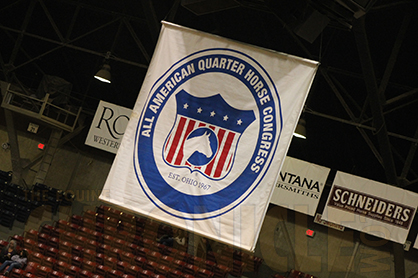CLARIFICATION- Horses From Certain Counties Banned From Attending QH Congress Due to Viral Disease
A recent press release from the Ohio Department of Agriculture indicated that due to recent confirmed and suspected cases of Vesicular Stomatitis in certain states, horses from those STATES would not be allowed entrance into Ohio. It further indicated that the restriction would include the All American Quarter Horse Congress. States where VSV has been detected include Colorado, Nebraska, New Mexico, Oklahoma, Texas, Utah, and Wyoming. However, a newly updated press release has just been released that clarifies that the restriction only applies to those specific COUNTIES within the states that have cases. A comment from the Quarter Horse Congress is expected to be forthcoming. The new ODA press release is listed below.
HORSES FROM CERTAIN AREAS BANNED FROM ALL AMERICAN QUARTER HORSE CONGRESS DUE TO HIGHLY CONTAGIOUS VIRAL DISEASE
Ohio Department of Agriculture
REYNOLDSBURG, OH (Sept. 9, 2019) – In an effort to protect horses and other livestock in Ohio, the Ohio Department of Agriculture (ODA) is not allowing the import of horses from counties within states with confirmed and suspected cases of Vesicular Stomatitis (VSV). This restriction includes the All American Quarter Horse Congress, which is scheduled to begin in Columbus on October 1.
“VSV has not been detected in Ohio and we are taking every precaution possible to keep it that way,” said ODA State Veterinarian Dr. Tony Forshey. “With the All American Quarter Horse Congress coming, we thought it was important to restrict further movement to prevent the disease’s potential spread.”
VSV is a viral disease that primarily affects horses, but can also infect cattle, swine, sheep, and goats. The disease causes blister-like lesions, which burst and leave open wounds. It is extremely painful to animals and can result in the inability to eat and drink and even lameness.
VSV is highly contagious, with biting insects being the most common method of transmission. Humans can also contract VSV by coming into contact with lesions, saliva, or nasal secretions from infected animals. In people, the disease causes flu-like symptoms such as fever, muscle ache, headache, and nausea.
Currently, VSV has been detected in Colorado, Nebraska, New Mexico, Oklahoma, Texas, Utah, and Wyoming with confirmed or suspected cases in specific counties across those states. A current list of suspect and confirmed cases can be found in the U.S. Department of Agriculture’s weekly situation report.
For more information on the disease, visit the USDA’s VSV resource page.
As can been seen by clicking on the most recent September 5th VSV report from the USDA, the counties with confirmed or suspected cases of VS include the following:
Colorado (3 new confirmed positive, 20 new suspect premises)
• Adams County – 1 new suspect premises
• Delta County – 3 new suspect premises
• Dolores County (New Infected County) – 1 confirmed positive premises
• Douglas County – 1 new suspect premises
• Jefferson County – 1 new confirmed positive, 5 new suspect premises
• La Plata County – 1 new suspect premises
• Mesa County – 2 new suspect premises
• Montezuma County – 1 new suspect premises
• Morgan County – 2 new suspect premises
• Pueblo County – 1 new suspect premises
• San Miguel County – 1 new suspect premises
• Weld County – 1 new confirmed positive, 2 new suspect premises
• Since the last situation report, 98 previously VSV-infected or suspect premises have been released from quarantine.
Nebraska (1 new confirmed positive premises)
• Morrill County (New Infected County) – 1 confirmed positive premises
• Since the last situation report, 3 previously VSV-infected premises were released from quarantine.
New Mexico
• Since the last situation report, 2 previously VSV-infected or suspect premises were released from quarantine.
Texas (1 new confirmed positive, 1 new suspect premises)
• Hays County – 1 new suspect premises
• Hill County (New Infected County) – 1 confirmed positive premises
• Since the last situation report, 18 previously VSV-infected or suspect premises have been released from quarantine.
Utah
• Since the last situation report, 6 previously VSV-infected or suspect premises have been released from quarantine.
Wyoming (6 new confirmed positive, 10 new suspect premises)
• Albany County – 2 new confirmed positive premises
• Big Horn County (New Infected County) – 1 confirmed positive premises• Carbon County – 1 new confirmed positive premises
• Goshen County – 1 new suspect premises
• Hot Springs County – 1 new confirmed positive, 1 new suspect premises
• Park County (New Infected County) – 1 new confirmed positive, 6 new suspect premises
• Platte County -2 new suspect premises
• Since the last situation report, 6 previously VSV-infected or suspect premises were released from quarantine.
However, further clarification will be needed to determine how long a county stays on the banned list of entrance to Ohio. The report indicates the following information for how long a typical quarantine lasts:
Quarantines
Confirmed positive and suspect premises are quarantined for at least 14 days from the onset of lesions in the last affected animal on the premises.
We expect further clarification will be coming from the Quarter Horse Congress and we will continue to update our readers when that information arrives.











